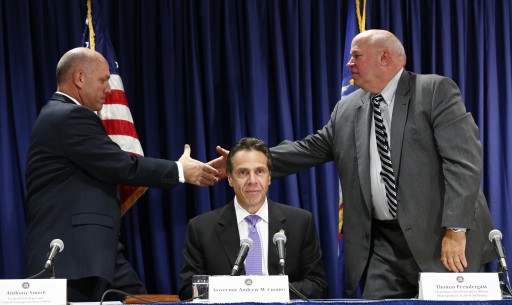 New York – Democratic Gov. Andrew Cuomo is well aware of the gambit.
New York – Democratic Gov. Andrew Cuomo is well aware of the gambit.
Subscribe to our Daily Roundup Email
In the 1994 gubernatorial race, 54,000 votes cast on the “Tax Cut Now” ballot line created by Republicans to highlight New York’s heavy tax load helped relatively unknown Republican state Sen. George Pataki upset Cuomo’s father, Mario.
This year, relatively unknown Republican Westchester County Executive Rob Astorino announced a plan to tap the votes of angry parents and educators by petitioning for a “Stop Common Core” line on the November ballot. Cuomo, despite massive leads in the polls and funding, launched a “Women’s Equality Party” line, announced by running mate Kathy Hochul and with endorsements from his girlfriend, Food Network star Sandra Lee, actress Lena Dunham and model Christie Brinkley.
In New York, 15,000 petition signatures are enough to claim a ballot line. It’s a legacy in state politics that good-government groups have tried to quash, arguing it promotes at least the appearance of corruption as candidates jockey for the support of minor parties.
“It’s this idea you can go to the highest bidder,” said Jeanne Zaino, political science professor at Iona College. “It’s important in a democracy to give people a clear choice.”
This year, Cuomo was at risk of losing the support of the labor-backed Working Families Party. But Cuomo overcame criticism he hadn’t been forceful enough in pursuing a liberal agenda by promising, among other things, to push harder for a package of bills on women’s issues that includes pay equity and stronger protection of abortion rights.
It’s unclear how well an issue party line will work for either campaign.
The 2010 election won by Cuomo featured Jimmy McMillan running on the “Rent Is Too Damn High” line. He pulled in just 41,000 of the roughly 4.7 million votes cast but made a big name for himself.
“I don’t think it’s anything to scoff at. There’s real votes there,” Zaino said.
But the issues chosen by Astorino and Cuomo aren’t high on the list of voters’ concerns, according to a Siena College Research Institute poll of likely voters in mid-July.
Asked which single issue will determine who they support, voters flagged jobs (13 percent), taxes (12 percent), education (12 percent) and the economy (9 percent). The SAFE Act gun controls was next, at 5 percent. Common Core came in at No. 14 on the list of 27 topics, with 1 percent of voters seeing it as their top concern. Women’s issues placed 24th.
“It’s pocketbook issues,” Siena pollster Steve Greenberg said of the perennial top concerns.
He said a separate question gauging upset over how New York has put the Common Core in place showed 49 percent of voters want the program stopped, with the heaviest support — 60 percent — among Republicans already likely to vote for Astorino. Greenberg said the line could help Astorino in New York City’s suburbs, where 49 percent want to end Common Core, and among independents.
“These are voters who Astorino might be saying, ‘You know, you don’t want to vote for me on the Republican line. I have a place you can support me,'” Greenberg said.
Cuomo is attempting the same, Greenberg said, in an election where more women tend to vote than men.
“Independent, Republican and suburban women might not be regular pullers of the Democratic line,” he said. “I think he’s looking to give them an opportunity to support him without having to pull the Democratic line.”
Zaino said the women’s equality agenda — mostly recently, the U.S. Supreme Court decision allowing some closely held private businesses to opt out of the federal health care law’s contraception provision — could be significant in motivating voters in a likely low-turnout, off-year election.
Will the advocacy lines attract voters?
“We have some pretty good data that angry people are more likely to call talk radio and mobilize to vote based on anger and negativity,” said Robert Pecorella, a St. John’s University professor of government and politics.
“Astorino has nothing to lose. It seems to be the latest thing the libertarian right has got their arms around,” he said. “That’s actually a pretty smart strategy for him.”
Zaino said she doesn’t think Astorino has been bold or surprising enough.
“I certainly don’t see this Common Core line as resonating in that way,” she said. “If he had done something on immigration, that might have been something that might get moderate Republicans and Democrats and independents to take another look at him.”
